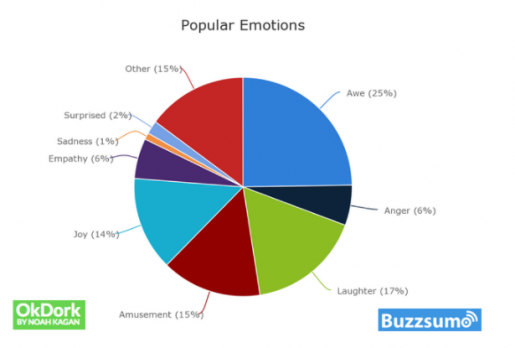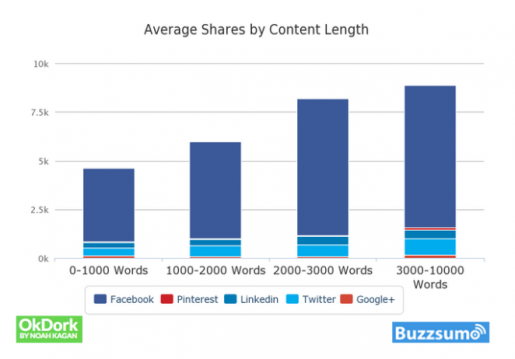
Blogging is an imprecise science. You might find that your reader engagement and social shares vary greatly from post-to-post, and these figures don’t always reflect the quality of the work you’re producing. For bloggers looking for a new content strategy that can increase click-through rates and drive sales, it might be time to consider data-driven blog posts.
Inspired by Neil Patel’s outstanding Beginner’s Guide to data-driven blog posts, we have listed five crucial steps to unlocking the potential of this content strategy.
-
1. Establish Your Target and Strategy
First things first – know who you are writing for. Zero in on a specific target market, and make sure the content you create adds value to their experience. It is important to establish why a reader will benefit from reading your post – aim to respond to an actual problem or query that your readers often have, rather than something that is just of passing interest to them.
There are two emotions that you must consider when writing targeted copy, according to Andy Maslen’s book Persuasive Copywriting:
- The Steady-State: A reader’s current emotion regarding a problem
- The Target Emotion: How you want them to feel having read your copy
These clearly defined terms can be helpful when considering a structure – you might begin by outlining the steady-state of a reader’s experience to empathise with them, before appealing to their target emotion in subsequent paragraphs.
When considering the tone of your work, remember that data-driven articles need not be dry and academic in nature. Research from OkDork into the top 10,000 most shared online articles yielded the following results on emotional tone.
The top three most popular emotions associated with blog posts were awe, laughter and amusement. Find the funny or surprising aspect of your topic, and watch engagement grow.
2. Mine the Best Data Sources
If you don’t trust the data you draw upon, how can you expect your readers to? Readers who see links to renowned and trusted organisations will naturally consider your work more credible.
Great statistical sites include publicly available data from sources such as Zanran and Guardian Data, and academic research sites like Google Scholar. Government organisations are an excellent source of trusted data – for Australia, data.gov.au hosts over 28,000 datasets that you can draw upon in your posts.
If you are an established blogger who has access to statistics gathered from your own experience, by all means use them. Proprietary research is unique to your own situation – while the sample sizes might be small, no other blogger will have access to the stats that you do.
3. Structure a Data-Driven Headline
For every ten people who click on your blog post, eight will read the headline but only two will progress to the bulk of your copy. This doesn’t mean you should you craft a dynamic headline and sleepwalk through the rest of your content, but it does underscore the importance of appealing headlines for engagement.
For data-driven articles, finding a method to naturally incorporate data in your headline is essential for content marketing. Specificity is crucial. If your aim is to prove to your readers that a certain trend is on the rise, consider using media publications to back up your assertion.
Neil Patel expertly demonstrates how to structure a data-driven headline based on a statistic in his Beginner’s Guide.
STATISTIC: 82% of marketers who blog daily acquired a customer using their blog.
EXAMPLE HEADLINES:
Case Study: How 82% of Marketers Acquire Customers Through Blogging
-
The Ultimate Strategy That 82% of Marketers Use to Acquire Customers
-
10 Effective Ways 82% of Marketers Get Customers by Blogging
4. Craft Your Content
Generally speaking, the more detail you provide in data-driven blog posts the better, provided the information is credible. While conventional wisdom regarding blog posts is that shorter and punchier articles are preferred, research by OkDork into the top 10 per cent most shared articles found that long-form content was shared significantly more often than short-form.
While you don’t need to go to this extent to engage your audience, ensure that you fully address the topic at hand and provide a call to action in line with your original aim.
5. Check Yourself…
Before you wreck your credibility. Fact-checking is crucial. It’s easy to get caught out by data or statistics that appear legitimate, and often further research will produce conflicting results. To ensure your readers can trust the content you link to, follow these rules for verification before you hit the post button.
- Ensure the sites you link to can be trusted – straightforward enough, but if you cannot find any other work that backs up the data offered you should tread carefully.
- Use data from published authors whenever possible – it’s fair to assume that if someone has researched and written a well-received book on a subject, they aren’t seeking to mislead with the content they produce.
- The data must explain the methods used to reach the conclusions made – if the data gathering procedure is vague or not mentioned in the article, it’s hard to be confident about the author’s credibility. If in doubt, leave it out.
To further increase your credibility in the eyes of the reader, ensure you write in an objective tone. While you are seeking to elicit a certain response from readers, that doesn’t mean you should overstate the conclusions drawn from research.
Data-driven blog posts can be tricky to master – the content you produce should be authoritative and provide a fair representation of the issue at hand, while still being accessible to your target audience. Get it right though, and the engagement results will make your hard work worthwhile.
Content Creation from Studio Culture
Studio Culture’s digital marketing team can create content that drives tangible results for your business. From data-driven blog posts to SEO, branding and content marketing, our talented team can reinvent your digital presence. To get in touch, call 1300 200 113 or email hello@studio-culture.com.au.



